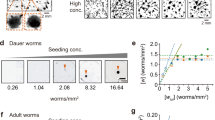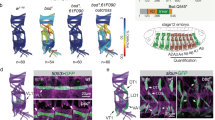Abstract
THE generation of cell diversity during the development of multicellular organisms involves a series of decisions between alternative pathways of differentiation1,2. In many instances the fate of a cell depends on its position, so that pattern formation and cell differentiation can become facets of the same process3. These phenomena occur in a simple form in the slime mould Dictyostelium discoideum where there are only two major pathways of differentiation—one leading to stalk cells and the other to spores. On starvation the individual amoebae aggregate chemo-tactically to form multicellular masses. Somewhat later the aggregates can be shown to consist of two distinct cell types: prestalk cells which are localised in the anterior and prespore cells in the posterior of the migrating slug4. We are interested in how the formation of these cell types is controlled. One approach to this problem involves experimentally inducing differentiation of cells that are somehow prevented from completing normal development. Starving cells plated on agar with a Cellophane overlay aggregate but remain constrained as a monolayer and do not progress to stalk or spore. But addition of 1–5 mM cyclic AMP to the agar results in efficient induction of stalk cell formation provided that a high cell density is used5–7. At low cell density stalk cells do not form unless a low-molecular weight factor, released by cells at high density, is also provided7. We show here that although no mature spores form in conditions of high cell density giving a high yield of stalk cells large numbers of prespore cells do appear. Many of these later transform into stalk cells. Prespore cells do not arise at low density but the density requirement for prespore cell formation, unlike that of stalk cells, cannot be efficiently replaced by the low-molecular weight factor. Five mutants isolated by virtue of their ability to form mature spores under Cellophane likewise do not form spores at low cell density even in the presence of the ‘helping’ factor. Thus entry of developing Dictyostelium cells into the prespore pathway apparently requires some cell interaction different from or additional to that required for entry into the stalk pathway.
This is a preview of subscription content, access via your institution
Access options
Subscribe to this journal
Receive 51 print issues and online access
$199.00 per year
only $3.90 per issue
Buy this article
- Purchase on Springer Link
- Instant access to full article PDF
Prices may be subject to local taxes which are calculated during checkout
Similar content being viewed by others
References
Kauffman, S. Ciba Fdn Symp. 29, 210–222 (1975).
Gardner, R. L. & Rossant, J. Ciba Fdn Symp. 40, 5–25 (1975).
Wolpert, L. Curr. Top. dev. Biol. 6, 183–224 (1971).
Raper, K. B. J. Elisha Mitchell Scientific Soc. 56, 241–282 (1940).
Bonner, J. T. Proc. natn. Acad. Sci. U.S.A. 65, 110–113 (1970).
Francis, D. Nature 258, 763–765 (1975).
Town, D., Gross, J. D. & Kay, R. R. Nature 262, 717–719 (1976).
Hohl, H. R. & Hamamoto, S. T. J. Ultrastruct. Res. 26, 442–453 (1969).
Maeda, Y. & Takeuchi, I. Development Growth Differentiation 11, 232–245 (1969).
Gregg, J. H. & Badman, S. Devl Biol. 22, 96–111 (1970).
Müller, U. & Hohl, H. R. Differentiation 1, 267–276 (1973).
Takeuchi, I. Devl Biol. 8, 1–26 (1963).
Hayashi, M. & Takeuchi, I. Devl Biol. 50, 302–309 (1976).
Forman, D. & Garrod, D. R. J. Embryol. exp. Morph. 40, 215–228 (1977).
Yu., N. Y. & Gregg, J. H. Devl Biol. 47, 310–318 (1975).
Takeuchi, I. & Sakai, Y. Development Growth Differentiation 13, 201–210 (1971).
Sakai, Y. & Takeuchi, I. Development Growth Differentiation 13, 231–240 (1971).
Town, C. D. & Stanford, E. J. Embryol. exp. Morph. (in the press).
Pan, P., Bonner, J. T., Wedner, H. J. & Parker, C. W. Proc. natn. Acad. Sci. U.S.A. 71, 1623–1625 (1974).
McMahon, D. Proc. natn. Acad. Sci. U.S.A. 70, 2396–2400 (1973).
Author information
Authors and Affiliations
Rights and permissions
About this article
Cite this article
KAY, R., TILLY, R. & GARROD, D. Requirement for cell differentiation in Dictyostelium discoideum. Nature 271, 58–60 (1978). https://doi.org/10.1038/271058a0
Received:
Accepted:
Published:
Issue Date:
DOI: https://doi.org/10.1038/271058a0
This article is cited by
-
Effects of sodium azide and trifluoperazine on growth, development and monolayer cell differentiation inDictyostelium discoideum
Journal of Biosciences (1995)
-
A possible morphogen controlling differentiation in Dictyostelium
Nature (1983)
-
Intracellular pH and the control of cell differentiation in Dictyostelium discoideum
Nature (1983)
-
A chymotrypsin-sensitive step in the development of Dictyostelium discoideum
Nature (1978)
Comments
By submitting a comment you agree to abide by our Terms and Community Guidelines. If you find something abusive or that does not comply with our terms or guidelines please flag it as inappropriate.



